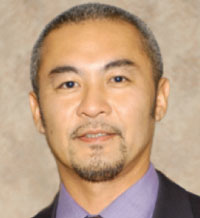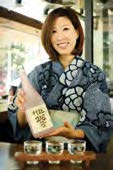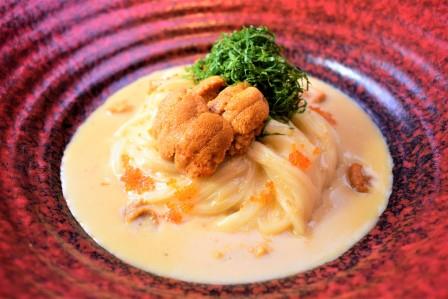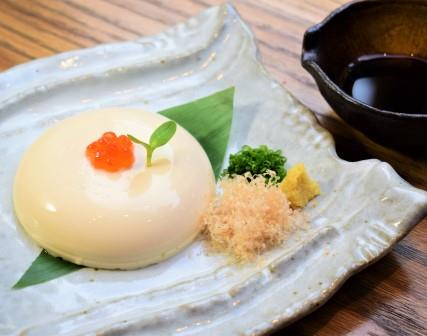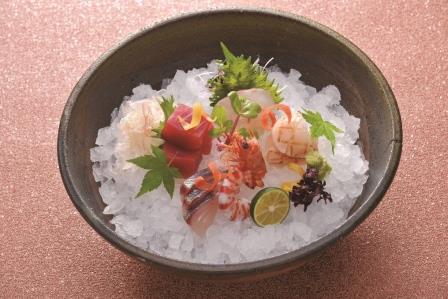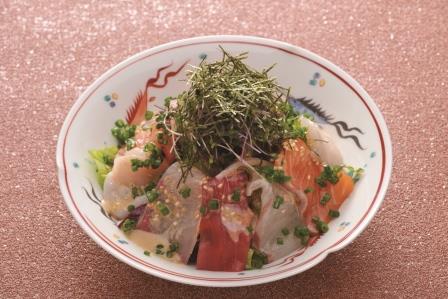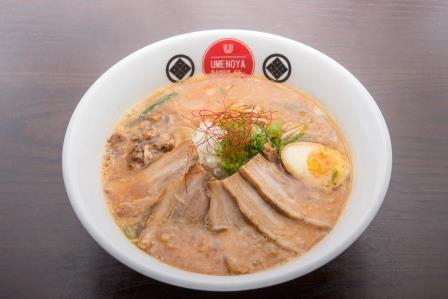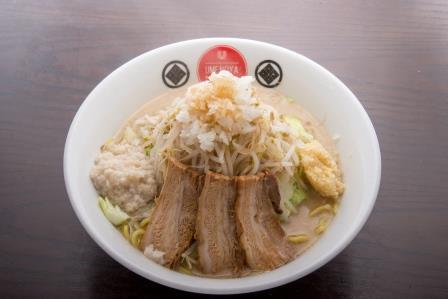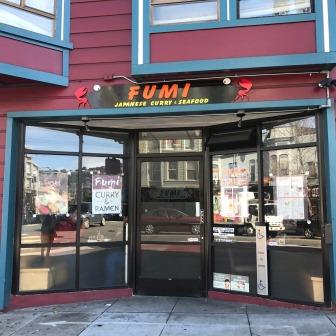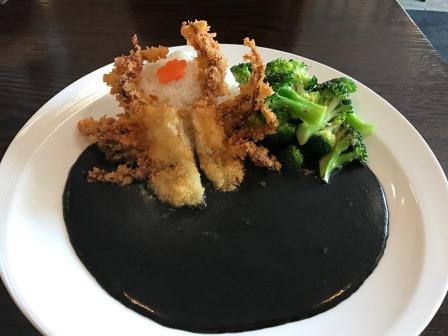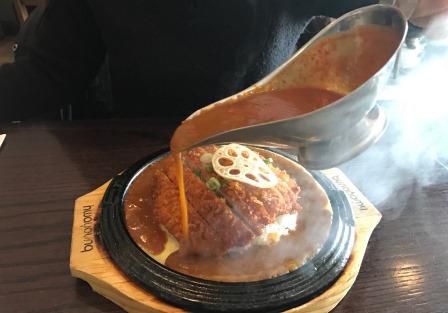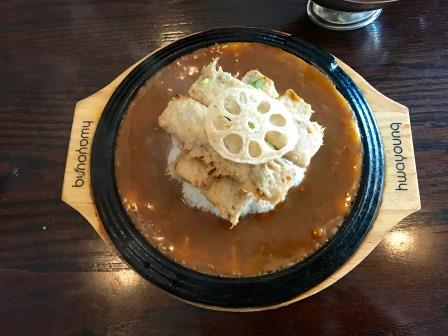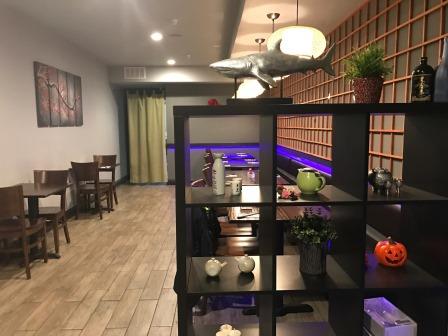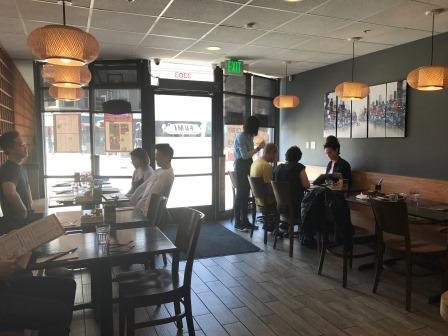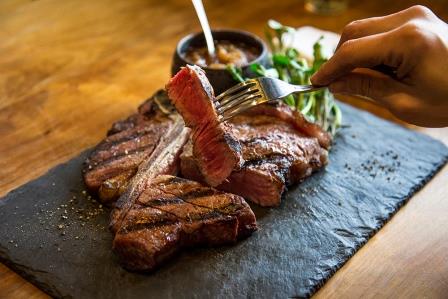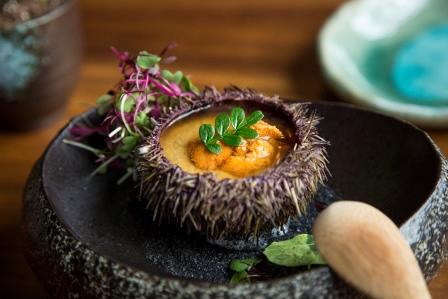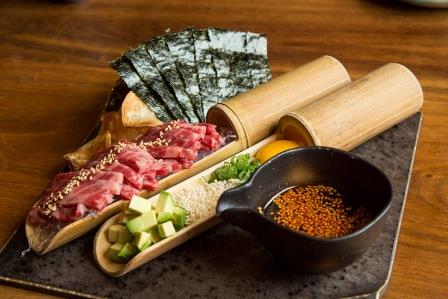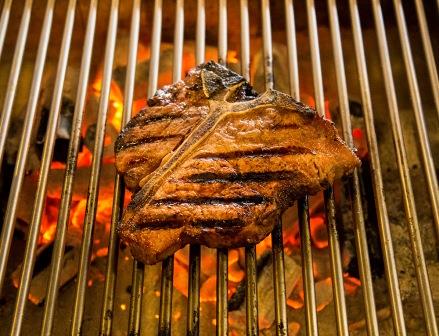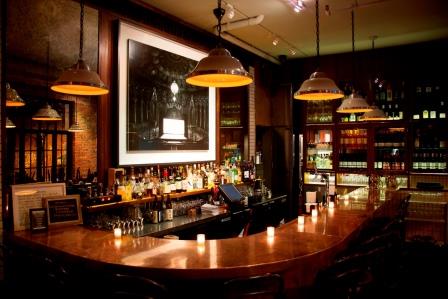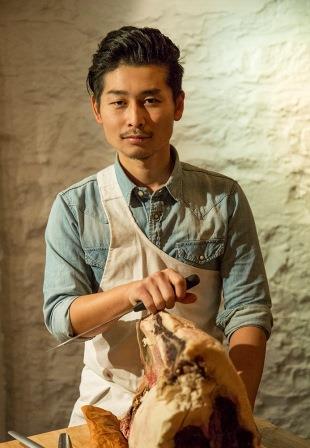First time in Napa Valley! True izakaya run by Californian chef
By Eri Shimizu / Editing: Elli Sekine
Although Napa Valley, known for its wine producing, is located in the Bay Area where many high-end and high-quality Japanese restaurants already exist, there was no Japanese restaurant in the valley. Finally, last year in 2016, Japanese restaurants such as “KENZO”, a high-end restaurant, started to open one after another. "Miminashi” is the first restaurant which opened there in May, and gained popularity quickly. The name, “Miminashi” was derived from a well-known Japanese folk tale, “Miminashi Hoichi”, which was chosen by the owner/chef Curtis Di Fede. He wished that the restaurant would last for a long time as a good restaurant just like the character Hoichi in the story who endured hardships throughout his life.
Mr. Curtis is from an American family from Napa, which has continued for four generations, which is rare in the US. He also grew up in Napa. After being trained in Michelin-star restaurants in Napa such as “Bouchon” and “Terra”, he became the chef of “Oenotori”, a southern-Italian style restaurant which was opened in 2010. Their casual menu using local ingredients gained a lot of repeat customers, and “Oenotori” grew to be a very popular restaurant loved by the local customers. However, in order to stay with his principle which is to stick to his original techniques, Mr. Curtis left “Oenotori”, and opened his own place for the first time. But, why a Japanese food restaurant?
For 3 years after leaving “Oenotori”, he went all over the world to eat specialty foods of each country. His first encounter with yakitori was at an outside vendor in Shinjuku. He was shocked to know that so many different parts of chickens were used, and there were so many different textures and tastes. He also fell in love with the lively atmosphere of izakaya-style restaurants, and wanted to bring it back to Napa, which triggered the opening of this first restaurant. In order to break the stereotypical image of Japanese food which equals to sushi, “Miminashi” purposely does not serve sushi. The heavy white wood door with numerous protrusions designed based on the image of Mt. Fuji is impressive.
Once you step inside, you are surrounded by customers who are filling the place in a noisy and lively ambience. There is a bar counter with wine and sake bottes in the middle, which naturally draws you to liquors first. On your left, there is a yakitori counter and tables from where you can see the Binchotan charcoal burning, and on your right are more private booths.
The main menu items are Binchotan charcoal broiled yakitori, ramen, and a-la-carte dishes. The chickens are brought in uncut, so in addition to regular yakitori parts such as liver and gizzard, they can serve rare parts in the States such as tail, hearts, and gristle. They even serve grilled skewers with ingredients other than chicken such as pork short rib, Maitake mushrooms, etc. The variety is as wide as they are in Japanese yakitori specialty restaurants. They even serve chicken sashimi when French blue leg chickens are available. For the ramen dishes, they serve different flavors such as rich tonkotsu or light seafood base depending on the weather of the day. As their particularity, Hokkaido konbu seaweed is used for all the ramen soup base as a common ingredient. The toppings such as marinated eggs, house-made kimchee, poached chicken slices, etc. are also offered varied depending on the day.
The ingredients are bought at the local markets weekly by the chef. He creates original a-la-carte menu items using local organic and seasonal ingredients that he buys. Examples of these are “Roasted Beets Salad” ($12) (made with popular Californian ingredients such as beets and blood oranges with nori and wasabi dressing), “Grilled Romanesco Cauliflower” ($8.50) (made with roasted cauliflower topped with yuzu, bonito shavings, and fried tempura batter crumbles), etc., which are a unification of local ingredients and Japanese flavors. The sashimi plate that changes daily is served with original condiments such as blood orange pepper, and fresh wasabi aired from Japan, which is an extra charged item.
The drink menu is selected with food paring in mind. The wide variety includes all kinds of sake brands from Hon-jozo to Junmai dai-ginjo, Japanese and local beers such as Asahi, COEDO, and Hitachino, and European wines.
Mr. Curtis is very particular about the soft-serve ice cream ($7). He encountered Hokkaido soft ice cream in Japan, and was so impressed. He wants to make it a popular American dessert that can surpass the boom of frozen yogurt. He is planning to open multiple soft ice cream specialty shops in the future. The restaurant in Napa is already so popular, and people including tourists wait in line to get in every day.
I asked him his prospects for the future. He said that he would like to keep introducing the charm of the collaboration of traditional Japanese tastes with Napa for now. I would like to see the success of this restaurant in becoming a long-lasting and well-loved izakaya which was finally born in Napa.
ナパバレー初!カリフォルニアシェフが繰り広げる本格居酒屋
高級店から庶民派まで日本食レストランが充実しているベイエリアにあって、ワインの生産地として有名なナパバレーは日本食空白地帯だった。
しかし昨年2016年、注目されるハイエンドの「KENZO」を始め、日本食レストランが相次いでオープンした。その先頭を切って去年5月にオープンした「Miminashi」がたちまち人気を集めている。日本人ならお馴染みの怪談「耳なし芳一」からとった店名にはオーナーシェフ、カーティス・ディ・フェーデ氏(Curtis Di Fede)の思い入れがある。同店が道中に「芳一」苦難があった時にも耐え、良き店として長く続くように、と。
カーティス氏はアメリカでは珍しい4世代続くナパ出身家系の4代目で ナパ育ち 。ナパバレーのミシュランスターレストラン、「Bouchon」や「Terra」で修行後、2010年にオープンした南イタリア料理店「Oenotori」のシェフとなる。ローカルの食材を使ったカジュアルな料理はリピーターを呼び、同店は地元客に愛される人気レストランに 成長した 。 しかし、シェフの独自の手法 を貫きたい思いから、同店を離任し、今回初めて独自店舗を構えた。でもなぜ日本食だったのか?
「Oenotori」を離職後3年間、カーティス氏は世界各地の食を食べ歩いた。カーティス氏が初めて焼き鳥と出会ったのは新宿の屋台。鶏にはこれほど沢山の部位があり、食感や味わいが違うのかと衝撃を受けたという。そして活気溢れる居酒屋の雰囲気をぜひ地元ナパにも再現したいと思いが今回のオープンにつながった。カーティス氏はアメリカ人のステレオタイプである寿司 というイメージを一新する如く、あえてMiminashiでは寿司を提供していない。富士山をイメージしたという無数の突起のついた重厚な白木のドアが印象的な店構え。扉を開け一歩中に入ると、満席の客の喧騒と熱気に包まれる。ワインや日本酒のボトルの並ぶバーが中央にあり、まずアルコールに目に入る。左手には備長炭の炎を見ながら食できる焼き鳥カウンターとテーブル席、右手に個室感覚のブース席がある。
メニューの中心は、備長炭で焼き上げる焼き鳥とラーメン、そして一品料理だ。ここ では、丸鶏を仕入れ、店内で捌くため、レバーや砂肝はもちろん、アメリカでは珍しいボンジリやハツモト、ヒザナンコツなどの部位も使用。さらに豚カルビや舞茸など鶏以外の串焼きもまるで日本の焼き鳥屋のように種類が豊富。さらにフランス原産の鶏ブルーレッグチキンが入荷した時には鳥刺しもある。一方、ラーメンのスープは濃厚な豚骨やあっさり魚介ベースなど、その日の天候によって変える。しかし、どのスープも共通してベースには北海道産の真昆布を使うのがこだわりだ。具材も味付け玉子や自家製のキムチ、ポーチドチキンなど日替わりである。
食材はカーティス氏が毎週マーケットに足を運び、 地元オーガニック食材を使った季節感がある一品料理メニューを創作する。野菜料理はRoasted Beet Salad($12)(ビーツやブラッドオレンジなどカリフォルニアで人気の組み合わせに海苔やわさびドレッシング)やGrilled Romanesco Cauliflower($8.5)(カリフラワーのローストに柚子や鰹節、天かすのトッピング)など、ローカル食材と日本のフレイバーが融合した料理が並ぶ。
日替わりメニューの刺身には、ブラッドオレンジ胡椒などオリジナルの薬味が添えられ、日本から空輸で仕入れるフレッシュわさびは別注文となる。
ドリンクメニューはフードペアリングを重視したセレクトで、本醸造から純米大吟醸までバラエティに富む日本酒、アサヒやCOEDO、Hitachinoなどの日本ビールとローカルビール、そしてヨーロッパワインも多く揃える。
もう一つカーティス氏がこだわるのはソフトクリーム($7)だ。北海道で出会ったソフトクリームに感動したカーティス氏は、アメリカでソフトクリームをフローズンヨーグルトブームを超える人気デザートにしたいと意気込み。今後のソフトクリーム専門店を複数店舗展開も目論む。すでにナパを訪れる観光客を中心に毎日行列ができるほど賑わっている。
カーティス氏に今後の展望を聞くと、まずは現在の店を地元の人から支持が得られるように日本伝統の味とナパのコラボの魅力を伝えていきたい とのこと。ようやくナパに誕生したIzakayaが多くの人に長く愛される 店になるのを期待したい。
Miminashi
821 Coombs St, Napa, CA 94559
(707) 254-9464
http://miminashi.com/
Mon.-Fri./11:30AM–2:30PM, 5:30–10:00PM (Fri. until 11:00PM)
Sat./5:00PM-11:00PM
Sun./5:00PM-9:30PM
Although Napa Valley, known for its wine producing, is located in the Bay Area where many high-end and high-quality Japanese restaurants already exist, there was no Japanese restaurant in the valley. Finally, last year in 2016, Japanese restaurants such as “KENZO”, a high-end restaurant, started to open one after another. "Miminashi” is the first restaurant which opened there in May, and gained popularity quickly. The name, “Miminashi” was derived from a well-known Japanese folk tale, “Miminashi Hoichi”, which was chosen by the owner/chef Curtis Di Fede. He wished that the restaurant would last for a long time as a good restaurant just like the character Hoichi in the story who endured hardships throughout his life.
Mr. Curtis is from an American family from Napa, which has continued for four generations, which is rare in the US. He also grew up in Napa. After being trained in Michelin-star restaurants in Napa such as “Bouchon” and “Terra”, he became the chef of “Oenotori”, a southern-Italian style restaurant which was opened in 2010. Their casual menu using local ingredients gained a lot of repeat customers, and “Oenotori” grew to be a very popular restaurant loved by the local customers. However, in order to stay with his principle which is to stick to his original techniques, Mr. Curtis left “Oenotori”, and opened his own place for the first time. But, why a Japanese food restaurant?
For 3 years after leaving “Oenotori”, he went all over the world to eat specialty foods of each country. His first encounter with yakitori was at an outside vendor in Shinjuku. He was shocked to know that so many different parts of chickens were used, and there were so many different textures and tastes. He also fell in love with the lively atmosphere of izakaya-style restaurants, and wanted to bring it back to Napa, which triggered the opening of this first restaurant. In order to break the stereotypical image of Japanese food which equals to sushi, “Miminashi” purposely does not serve sushi. The heavy white wood door with numerous protrusions designed based on the image of Mt. Fuji is impressive.
Once you step inside, you are surrounded by customers who are filling the place in a noisy and lively ambience. There is a bar counter with wine and sake bottes in the middle, which naturally draws you to liquors first. On your left, there is a yakitori counter and tables from where you can see the Binchotan charcoal burning, and on your right are more private booths.
The main menu items are Binchotan charcoal broiled yakitori, ramen, and a-la-carte dishes. The chickens are brought in uncut, so in addition to regular yakitori parts such as liver and gizzard, they can serve rare parts in the States such as tail, hearts, and gristle. They even serve grilled skewers with ingredients other than chicken such as pork short rib, Maitake mushrooms, etc. The variety is as wide as they are in Japanese yakitori specialty restaurants. They even serve chicken sashimi when French blue leg chickens are available. For the ramen dishes, they serve different flavors such as rich tonkotsu or light seafood base depending on the weather of the day. As their particularity, Hokkaido konbu seaweed is used for all the ramen soup base as a common ingredient. The toppings such as marinated eggs, house-made kimchee, poached chicken slices, etc. are also offered varied depending on the day.
The ingredients are bought at the local markets weekly by the chef. He creates original a-la-carte menu items using local organic and seasonal ingredients that he buys. Examples of these are “Roasted Beets Salad” ($12) (made with popular Californian ingredients such as beets and blood oranges with nori and wasabi dressing), “Grilled Romanesco Cauliflower” ($8.50) (made with roasted cauliflower topped with yuzu, bonito shavings, and fried tempura batter crumbles), etc., which are a unification of local ingredients and Japanese flavors. The sashimi plate that changes daily is served with original condiments such as blood orange pepper, and fresh wasabi aired from Japan, which is an extra charged item.
The drink menu is selected with food paring in mind. The wide variety includes all kinds of sake brands from Hon-jozo to Junmai dai-ginjo, Japanese and local beers such as Asahi, COEDO, and Hitachino, and European wines.
Mr. Curtis is very particular about the soft-serve ice cream ($7). He encountered Hokkaido soft ice cream in Japan, and was so impressed. He wants to make it a popular American dessert that can surpass the boom of frozen yogurt. He is planning to open multiple soft ice cream specialty shops in the future. The restaurant in Napa is already so popular, and people including tourists wait in line to get in every day.
I asked him his prospects for the future. He said that he would like to keep introducing the charm of the collaboration of traditional Japanese tastes with Napa for now. I would like to see the success of this restaurant in becoming a long-lasting and well-loved izakaya which was finally born in Napa.
ナパバレー初!カリフォルニアシェフが繰り広げる本格居酒屋
高級店から庶民派まで日本食レストランが充実しているベイエリアにあって、ワインの生産地として有名なナパバレーは日本食空白地帯だった。
しかし昨年2016年、注目されるハイエンドの「KENZO」を始め、日本食レストランが相次いでオープンした。その先頭を切って去年5月にオープンした「Miminashi」がたちまち人気を集めている。日本人ならお馴染みの怪談「耳なし芳一」からとった店名にはオーナーシェフ、カーティス・ディ・フェーデ氏(Curtis Di Fede)の思い入れがある。同店が道中に「芳一」苦難があった時にも耐え、良き店として長く続くように、と。
カーティス氏はアメリカでは珍しい4世代続くナパ出身家系の4代目で ナパ育ち 。ナパバレーのミシュランスターレストラン、「Bouchon」や「Terra」で修行後、2010年にオープンした南イタリア料理店「Oenotori」のシェフとなる。ローカルの食材を使ったカジュアルな料理はリピーターを呼び、同店は地元客に愛される人気レストランに 成長した 。 しかし、シェフの独自の手法 を貫きたい思いから、同店を離任し、今回初めて独自店舗を構えた。でもなぜ日本食だったのか?
「Oenotori」を離職後3年間、カーティス氏は世界各地の食を食べ歩いた。カーティス氏が初めて焼き鳥と出会ったのは新宿の屋台。鶏にはこれほど沢山の部位があり、食感や味わいが違うのかと衝撃を受けたという。そして活気溢れる居酒屋の雰囲気をぜひ地元ナパにも再現したいと思いが今回のオープンにつながった。カーティス氏はアメリカ人のステレオタイプである寿司 というイメージを一新する如く、あえてMiminashiでは寿司を提供していない。富士山をイメージしたという無数の突起のついた重厚な白木のドアが印象的な店構え。扉を開け一歩中に入ると、満席の客の喧騒と熱気に包まれる。ワインや日本酒のボトルの並ぶバーが中央にあり、まずアルコールに目に入る。左手には備長炭の炎を見ながら食できる焼き鳥カウンターとテーブル席、右手に個室感覚のブース席がある。
メニューの中心は、備長炭で焼き上げる焼き鳥とラーメン、そして一品料理だ。ここ では、丸鶏を仕入れ、店内で捌くため、レバーや砂肝はもちろん、アメリカでは珍しいボンジリやハツモト、ヒザナンコツなどの部位も使用。さらに豚カルビや舞茸など鶏以外の串焼きもまるで日本の焼き鳥屋のように種類が豊富。さらにフランス原産の鶏ブルーレッグチキンが入荷した時には鳥刺しもある。一方、ラーメンのスープは濃厚な豚骨やあっさり魚介ベースなど、その日の天候によって変える。しかし、どのスープも共通してベースには北海道産の真昆布を使うのがこだわりだ。具材も味付け玉子や自家製のキムチ、ポーチドチキンなど日替わりである。
食材はカーティス氏が毎週マーケットに足を運び、 地元オーガニック食材を使った季節感がある一品料理メニューを創作する。野菜料理はRoasted Beet Salad($12)(ビーツやブラッドオレンジなどカリフォルニアで人気の組み合わせに海苔やわさびドレッシング)やGrilled Romanesco Cauliflower($8.5)(カリフラワーのローストに柚子や鰹節、天かすのトッピング)など、ローカル食材と日本のフレイバーが融合した料理が並ぶ。
日替わりメニューの刺身には、ブラッドオレンジ胡椒などオリジナルの薬味が添えられ、日本から空輸で仕入れるフレッシュわさびは別注文となる。
ドリンクメニューはフードペアリングを重視したセレクトで、本醸造から純米大吟醸までバラエティに富む日本酒、アサヒやCOEDO、Hitachinoなどの日本ビールとローカルビール、そしてヨーロッパワインも多く揃える。
もう一つカーティス氏がこだわるのはソフトクリーム($7)だ。北海道で出会ったソフトクリームに感動したカーティス氏は、アメリカでソフトクリームをフローズンヨーグルトブームを超える人気デザートにしたいと意気込み。今後のソフトクリーム専門店を複数店舗展開も目論む。すでにナパを訪れる観光客を中心に毎日行列ができるほど賑わっている。
カーティス氏に今後の展望を聞くと、まずは現在の店を地元の人から支持が得られるように日本伝統の味とナパのコラボの魅力を伝えていきたい とのこと。ようやくナパに誕生したIzakayaが多くの人に長く愛される 店になるのを期待したい。
Miminashi
821 Coombs St, Napa, CA 94559
(707) 254-9464
http://miminashi.com/
Mon.-Fri./11:30AM–2:30PM, 5:30–10:00PM (Fri. until 11:00PM)
Sat./5:00PM-11:00PM
Sun./5:00PM-9:30PM

